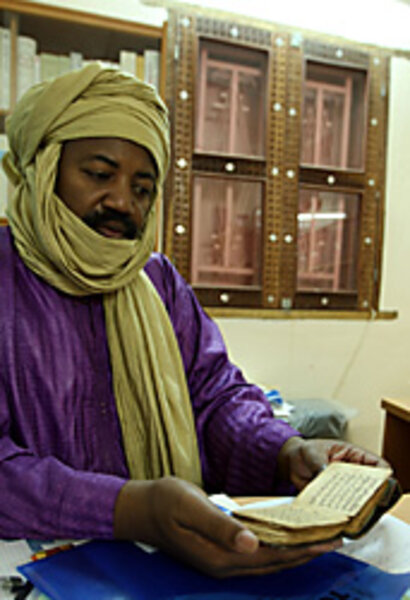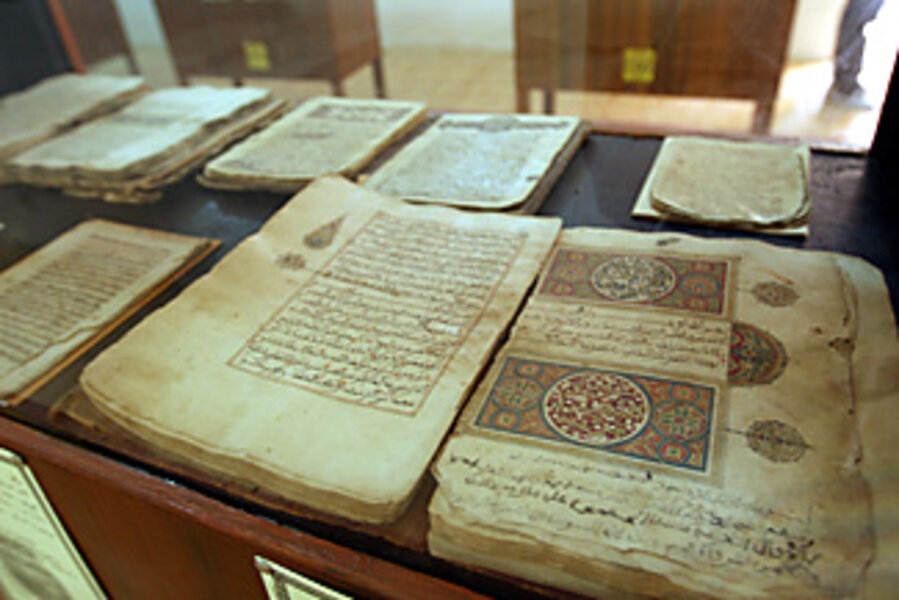In Timbuktu, a new move to save ancient manuscripts
Loading...
| Timbuktu, Mali
Abdel Kader Haidara carefully picks up one of a dozen small leather-bound books lying on his desk and leafs through the age-weathered pages covered in Arabic calligraphy.
This tiny book is centuries old and one of more than 100,000 manuscripts that can be found on shelves and in boxes in Timbuktu, the ancient Malian city of mud-brick walls nestled between the Niger River and the Sahara Desert.
"The manuscripts are our heritage," says the curator of the Mamma Haidara Manuscript Library, the largest of more than 20 private libraries in the city. "They have been passed from generation to generation. They are the history of Africa, the history of mankind."
But if not for an $8 million donation from South Africa, this history might have been lost forever.
The manuscripts in Arabic and African languages cover almost every conceivable subject from history and medicine to law and human rights, from astronomy and philosophy to conflict resolution and literature. It's a Who's Who of ancient kingdoms. Some are close to a thousand years old, written on paper, tanned gazelle skin, or tree bark, and they provide a rare glimpse into a precolonial African history of intellectual endeavor, historians say.
"It is often thought that there was no writing in Africa but the manuscripts prove otherwise," says Mohamed Gallah Dicko, director-general of the Ahmed Baba Institute, named after Timbuktu's leading 15th-century scholar. "Before and during our colonization there was writing."
The manuscripts are threatened by the desert's harsh environment, by family neglect, and a scarcity of funds for preservation in the world's fifth poorest country. South Africa has stepped in and later this year will complete construction of a new library and research center a few yards from the high, mud walls and minarets of the Sankoré Mosque which was, 400 years ago, itself a center of learning with 25,000 students and teachers.
Riason Naidoo, the South African project manager for the new library, says it is important that this is an African initiative. "Normally funding comes in from aid organizations from the West. The difference with this project is that Africans are collaborating to preserve their own heritage for future prosperity."
The library is backed by South African President Thabo Mbeki, who has called the manuscripts "among the most important cultural treasures in Africa" and key to his notion of an African Renaissance to rival that of Europe in the late Middle Ages. The project is also supported by the Pan-African New Partnership for Africa's Development (NEPAD), which named the preservation of the manuscripts as its first cultural project.
Today Timbuktu is a crumbling sleepy outback, reliant upon foreign tourism for survival. It was not always so: in its medieval heyday – as Europeans hacked at one another with swords, suffered the Black Death, and emerged blinking from the Dark Ages – Timbuktu was a thriving crossroads for trade in gold, salt, and slaves. It was the center of great empires and the intellectual heart of Africa.
It is no longer the unreachable city of explorers' myths (the first Europeans did not get to Timbuktu until the 19th century), yet it remains remote, taking more than two days' travel by four-wheel drive vehicle from the Malian capital, Bamako.
At the Ahmed Baba Institute the new library cannot come too soon as each passing month sees manuscripts deteriorate and disappear. The institute's 30,000-strong collection will be housed in the library and made available to visiting researchers and tourists alike.
The manuscripts may also have a few messages for the modern world, says Dr. Dicko. "Here in Timbuktu there is no militant Islam, it is peaceful. Look across the road, there is a Catholic church! We all live together. In the [Western] world outside, 'Islam' is a dirty word. But not here. Here there is mutual respect."
These sentiments are echoed by Mr. Haidara, who, for years before taking charge of the family library, criss-crossed the desert seeking out lost manuscripts. He says his favorite manuscripts are those that deal with conflict resolution and the tolerance that is at the heart of Islam.
And locally the centuries-old manuscripts may once again offer hope for the future of the ancient city, this time in the form of tourist dollars as Timbuktu seeks to reassert its position in the modern world.






